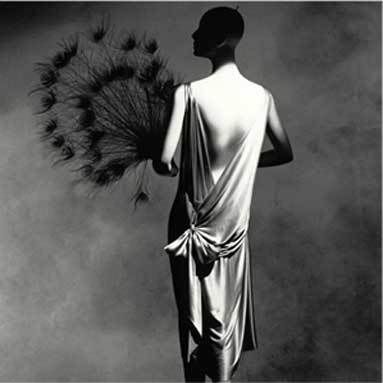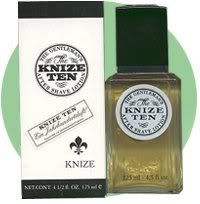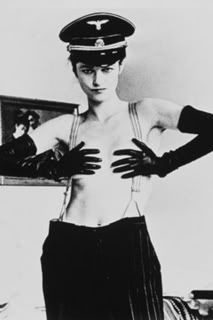Knize Ten is a 1924 fragrance composed by Vincent Roubert (who worked with Coty on L’Or and L’Aimant) for the Viennese tailor Knize. The Knize boutique was famously designed in 1913 by architect Adolf Loos, whose anti-Art Nouveau essay, Ornament and Crime, helped define Modernist aesthetics with its smooth surfaces and pure play on volume.
The scent itself was introduced to complement the clothier’s first ready-to-wear men’s line and in its opening notes, it clearly speaks in a masculine tone. The leather, paired with bergamot, petitgrain, orange, lemon and the slightly medicinal rosemary, is as dryly authoritative as a sharply-cut gabardine suit. As it eases into wear, rose, orris and carnation throw in a gender-bending curve ~Marlene Dietrich (herself a Knize patron) may have well slipped into that suit… The leather itself is of that of the wrist-watchband or fine shoe rather than the pungent “cuir de russie” boot. But despite the richly animalic base – musk, amber and castoreum – hinting at bridled desires, Knize Ten retains the buffered, well-bred smoothness of gentleman who never felt the need to set foot in the cigar-smoke laden cabinet of Herr Doktor Freud…
by guest writer Carmencanada
Notes for Knize Knize Ten:
Top: petit grain, orange, lemon, rosemary and bergamot.
Heart: rose, iris, carnation, cinnamon, clove, cedar, patchouli and sandalwood
Base: castoreum, ambergris, musk and moss.
Showing posts with label knize ten. Show all posts
Showing posts with label knize ten. Show all posts
Tuesday, November 23, 2010
Tuesday, December 18, 2007
Leather Series 8: The Garçonne Leathers of the 1920s (part 2)

by guest writer Denyse Beaulieu
Tabac Blond was the opening salve of the garçonnes’ raid on gentlemen’s dressing tables. Its name evokes the “blonde” tobacco women had just started smoking in public (interestingly, Marlboros were launched as a women’s brand in 1924 with a red filter to mask lipstick traces). The fragrance was purportedly meant to blend with, and cover up, the still-shocking smell of cigarettes: smoking was still thought to be a sign of loose morals.
Despite its name, Tabac Blond is predominantly a leather scent, the first of its family to be composed for women and as such, a small but significant revolution. Though perfumery had recently started to stray from the floral bouquets thought to be the only fragrances suitable for ladies (Coty Chypre was launched in 1917), it had never ventured so far into the non-floral. Granted, there are floral notes, but apart from ylang-ylang, the clove-y piquancy of carnation and the cool powdery metallic note of iris don’t stray much from masculine territory. Amber and musk smooth down the bitter smokiness of the leather/tobacco leaf duet, providing the opulent “roundness” characteristic of classic Carons. And it is this ambery-powdery base – redolent of powdered faces and lipstick traces on perfumed cigarettes – that pulls the gender-crossing Tabac Blond back into feminine territory to the contemporary nose, despite Luca Turin’s calling it “dykey and angular and dark and totally unpresentable” in Chandler Burr’s Emperor of Scent.
.jpg) Like its younger sister Habanita (1921), Tabac Blond’s rich, golden-honeyed, slightly louche sillage speaks of late, smoke-laden nights at the Bal Nègre in the arms of Cuban aristocrats or déclassé Russian émigrés, rather than exhilarating rides in fast cars driven by the new Eves…
Like its younger sister Habanita (1921), Tabac Blond’s rich, golden-honeyed, slightly louche sillage speaks of late, smoke-laden nights at the Bal Nègre in the arms of Cuban aristocrats or déclassé Russian émigrés, rather than exhilarating rides in fast cars driven by the new Eves…Not so Knize Ten, the 1924 fragrance composed by Vincent Roubert (who worked with Coty on L’Or and L’Aimant) for the Viennese tailor Knize. The Knize boutique was famously designed in 1913 by architect Adolf Loos, whose anti-Art Nouveau essay, Ornament and Crime, helped define Modernist aesthetics with its smooth surfaces and pure play on volume. The scent itself was introduced to complement the clothier’s first ready-to-wear men’s line and in its opening notes, it clearly speaks in a masculine tone. The leather, paired with bergamot, petitgrain, orange, lemon and the slightly medicinal rosemary, is as dryly authoritative as a sharply-cut gabardine suit. As it eases into wear, rose, orris and carnation throw in a gender-bending curve ~Marlene Dietrich (herself a Knize patron) may have well slipped into that suit… The leather itself is of that of the wrist-watchband or fine shoe rather than the pungent “cuir de russie” boot. But despite the richly animalic base – musk, amber and castoreum – hinting at bridled desires, Knize Ten retains the buffered, well-bred smoothness of gentleman who never felt the need to set foot in the cigar-smoke laden cabinet of Herr Doktor Freud…
His twin sister Chanel Cuir de Russie (also 1924) clearly departs from the butch Cossack boot and its birch-tar roughness. In fact, in an anecdote told by the composer Ernest Beaux to Chanel’s second perfumer Henri Robert, and transmitted to the third perfumer of the house, Jacques Polge, this particular “cuir” was meant to reproduce the delicate smell of the fine leather pouches wrapping precious jewel – another type of loot, as it were, than what the Cossack bore away on their horses. Cuir de Russie is a tribute to the impact of the Russian émigrés on the intellectual and aesthetic life of 1920s Paris -- Beaux himself, of course, was a Russian exile of French descent and Mademoiselle’s fashion house was peopled with elegant Russian aristocrats hired as sales assistants and models – as well as a radically modernist reworking of a by-then decades-old theme.
But more later in Helg’s review…
Photo by Irving Penn courtesy of ArtPhotoGallery.com, painting by Jack Vettriano Fetish, courtesy of angelarthouse
Thursday, July 19, 2007
The Agony and the Ecstacy part1: sadomasochism in fragrance

The rather outré title of this new latest series on Perfume Shrine is not meant as a direction to non-perfume venues of a niche of a quite different nature than that of the likes of afficionados of Lutens or Malle. Because here we will most certainly include perfume references by those two and lots of others, exploring just how certain scents play up on our subconscious and produce feelings of sensual surprise, olfactory submission and adoring intimidation or on the contrary a heightened sense of domination over all we survey.
If only Le Marquis and Leopold von Sacher had explored those avenues more fully.
Before we proceed any further, please note that the following are musings and thoughts that do not bind the author and are not meant to condone or approve of any practice or misunderstanding that you might have in mind. (This disclaimer of sorts is necessary to include because the term has been so much abused and tied to issues that are peripheral to it that it has gained a reputation that is inaccurate).
Perfume is fantasy. It has a weird effect on the psyche. And tied as it is to memory and sexuality it brings out elements of both to the fore, whether we desire it or not. Of course apart from the infamous Hirsch studies on what scents arouse and attract the opposite sex ~which are the matter of Googling searches all the time~ more importantly there is the element of how a particular fragrance makes the wearer themselves feel. This is the apex of the matter to my mind. Because perfume is so often worn for the enhancement of a mood or the desire to extol certain properties of the individual's personality, how one perceives said personality or mood is paramount when choosing what to wear. So a perfume with innocent, cherubic ambience would be more likely to evoke or pronounce a mood of traditionally viewed submissive femininity whereas a butch leather would reinforce the notion of a dominating persona. Or even the reverse if one is playing with boundaries and values the element of surprise!
Therefore are there specific perfumes that explore those pathways of the mind and playfully twist and turn them upside down for a perfume lover's rejoice? I think there are.
As cinematic experiences are so often deeply ingrained into Perfume Shrine, the quintessential film that displays the weird dynamic of an S/M relationship resplendent with a couple of perfume references is none other than "Il Portiere di Notte"/"The Night Porter"(1974) by Liliana Cavani featuring exquisite actors and personal favourites Dirk Bogarde and Charlotte Rampling. The film tells the tale of an ex-Nazi who falls in love with one of the Holocaust victims as many years later, both alive ~she, Lucia, a married woman; he, Max, a night porter~ they meet again at a Vienna hotel and reprise their strange affair surrounded by a hostile former Nazi crowd who seeks to gain power again with Max's assistance.
The doomed relationship of the two lovers reflects both aspects of control and surrender in alternating roles of great cinematic value. And although the mere thought of the Holocaust is assuredly distressing, the film manages to be respectful of the issues raised and focus on the personal angle rather than the historical repercussions.
You can watch a superb clip of it clicking on the screen or clicking here.
For an elaborate and long piece of how a viewer interprets the storyline I direct you to this post by The Scented Salamander.
Succinctly put:
Perfumes in Night Porter appear to be used to express ideas about sexuality, class, and inter-subjective relationship. Perfumes here, instead of elevating and idealizing the characters, making them appear more desirable and noble, are brought in to express not love, but prostitution, not attraction, but repulsion, not refinement but coarseness, not harmony, but destruction, not love, but a pathological manifestation of it.
There is also this link that mentions it in the context discussed.
Indeed perfumes in this film are seen through an altered lens and make us view scent as a means of control, rejection, social climbing or even manipulation and domination. It is an interesting axe to grind and worth pondering on.
So what would the ex-Nazi in hiding wear or the beautiful formerly submissive Lucia who reprises her role with a twist of unexpected ferocity?

As leather has been so ingrained into associations with S/M and isobutyl quinoline is the main ingredient used to render leather notes in perfumery, apart from the natural process of curing birch tar, I would propose Knize Ten for the character of Max. The fact that it comes from as far back as 1924 and Vienna in particular did not escape my attention either and may have contributed to this choice.
The history of Messrs. J. Knize dates back to 1858, based in Vienna. Within a little while fashion tailor J. Knize was appointed purveyor to K&K Royal Court and by the turn of the century many famous people, heads of states, artists, and industrialists were clientele to Knize. During the 1920s Knize's boutiques for men were established in the fashion cities of Paris, New York, London and Berlin. Although other scented offerings by Knize have been discontinued the iconic perfume remains still in production.
The fragrance is immediately redolent of raw cured leather that is pitch-black and tight, fits like a glove and is stained with the old fashioned aroma of smoke and a bit of turpentine. This shocking introduction laced with citrusy notes is testament to the power and suggestion such a smell holds over willing subjects. Woody and floral notes of subtle spiciness tone down this perverse beast resting it on a slightly powdery and incensy drydown that surprises yet again with its unexpected twists. Max in it would exude all the force of his uniformed days, when he could chop off the head of a prisoner who bothered his lover and present it John-the-Baptist-like to his own Salome. And yet he would also hide the pain that we can see in his eyes as he realises that there is no future for them, when they dare to exit the bastion of their seiged apartment towards dawn.

Its reputation precedes it as people either love it or hate it but they all remain astounded by the sheer innovation of it at the time it first launched, directing others into exploring difficult notions of bracing top notes that might shock and disturb. A scent that is definitely meant for people into a certain degree of sadomasochism, as the opening note of mentholated Vicks rub hits your nostrils with the ferocity of a typhoon to subside after a little while into an armload of rubbery tuberose married to soft spoken buttery lilies. A soothing, warm, human caress after the sting of pain.
Comparable to what Jean Cocteau had said about Marlen Dietrich and her name: "Starts with a caress; ends with a whipstroke". But in reverse. Which makes it eminently suitable...
Next post will continue with more perfume and film suggestions on the naughty path. You have been warned!
Top pic courtesy of sadist.gr Clip comes from Youtube. Pic of Knize Ten comes from basenotes.net. Pic of Charlotte Rampling from charlotterampling.net
Subscribe to:
Comments (Atom)
This Month's Popular Posts on Perfume Shrine
-
First things first: We are honored to participate for the 6th consecutive year in the Advent Calendar of Tauer Perfumes . You know what thi...
-
We have a glorious giveaway today on Perfume Shrine, courtesy of niche perfumer Andy Tauer and his Advent calendar project he conducts every...
-
Listening to the deep baritone of Thorsten Biehl’s voice confirms what I suspected from wearing his perfumes: he does not take fools gladly,...
-
When I was testing Une rose chyprée for the first time, I was eating creamy Greek yoghurt sprinkled with shredded Valhrona 72% dark chocola...
-
It's unusual in perfumery for the start of this century to encounter a modern composition which focuses on that loaded term which is dre...
-
Coco by Chanel must be among a handful of fragrances on the market to have not only one, but two flankers without being a spectacular marke...
.jpg)







